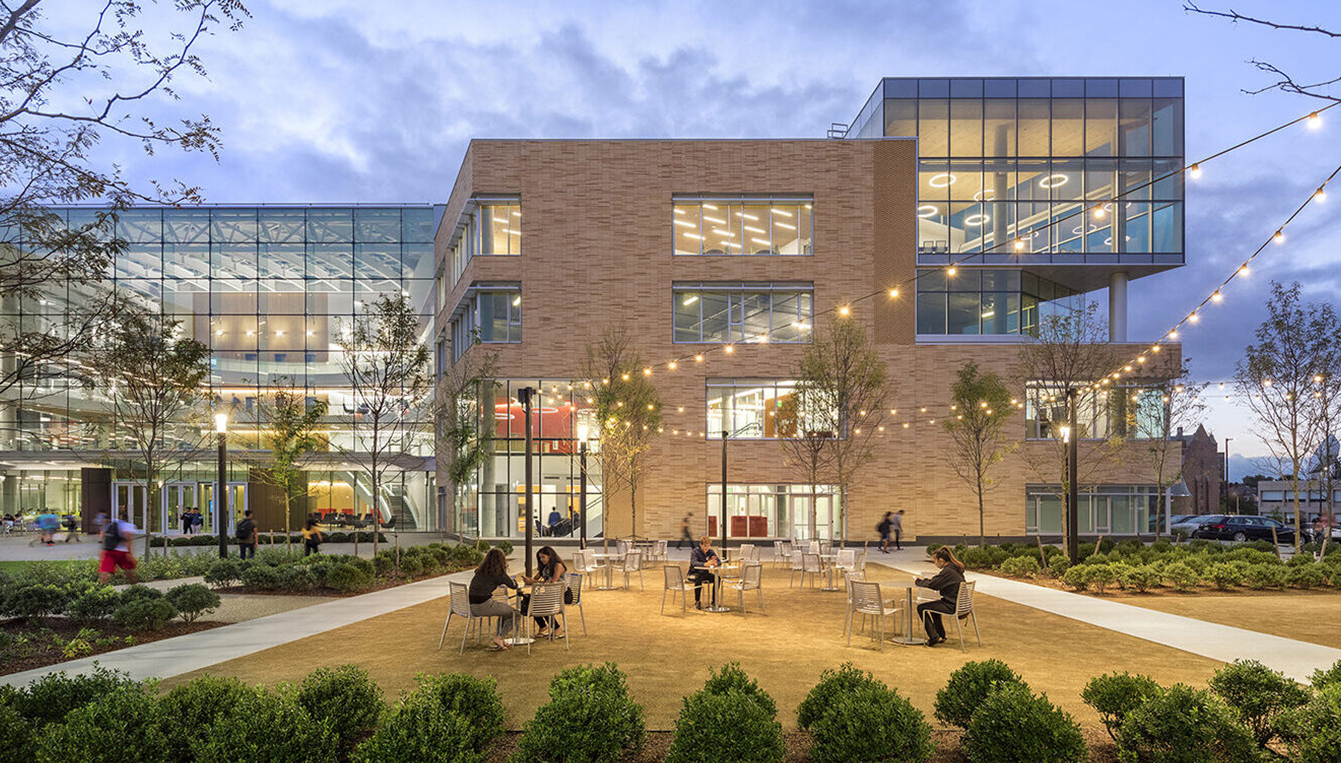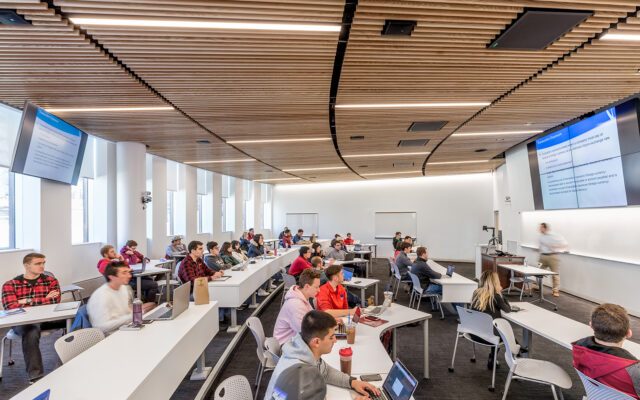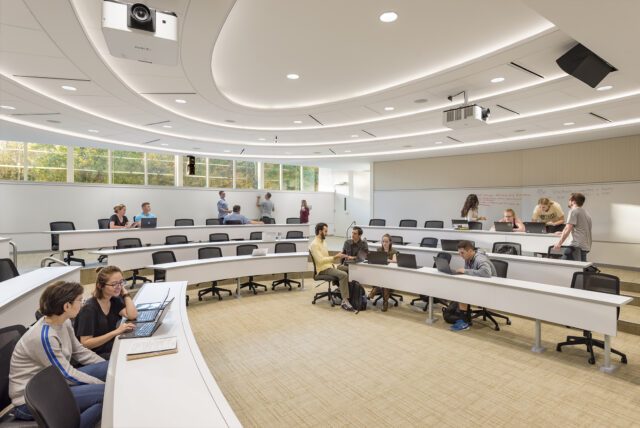Corey Salvatore
Director, Technology Group
Principal

Online learning is by no means a new concept. Colleges and universities have been deploying these kinds of teaching modalities for a number of years, and some are even specifically built around this type of instruction method. However, in today’s current world of academia, the COVID virus has put a new emphasis on these types of educational styles. And in new and challenging ways of course, once you factor in issues like social distancing, proper cleaning techniques, and providing a useful level of interaction between students and instructor.
If you’ve read Part 1 of this 2-part series, then you already know that there are a number of facets to this approach to teaching. If you haven’t read it (which I recommend doing if you’re interested) it addresses some of them, in particular the acoustics related aspects, which that post primarily focused on. In this portion, I will be focusing more on the technology side of things and how they apply to the “hybrid” format.
There is a vast myriad of considerations when it comes to hybrid learning spaces. Many of them involve proper investigation, planning, and deployment. Such as: putting tools/infrastructure in place to support remote instruction, training instructors on how to use new systems, training technical staff to support them, and even potential changes in teaching pedagogy. One of the key factors is also to avoid disengagement of the remote students. Therefore, a well designed and implemented AV system shouldn’t force you to compromise between outcome and method. Below we will go over some system design topics to help you make some educated decisions on what’s best for your hybrid learning environment.
It goes without saying in many aspects of presentation, be it classroom instruction or otherwise, that “content is king”. The same is true here. To that end, capturing and disseminating that content is a critical component of the hybrid environment. Not only for the remote participants but for those still locally present as well. For example, one needs to address speech reinforcement (for local students, who are now likely more spread out and taking up a larger space, due to distancing rules), the capture of the instructor’s speech (for the remote students), and capture of the local student’s speech as well (so the remote students can hear questions asked).
Microphones
When selecting the proper microphone system, assuming the room acoustics are in the proper order, some are going to better suit your needs than others. So where you may have traditionally gone with a wireless microphone system, a fixed wired solution would be a better alternative. This could be a system of fixed in place microphones, mounted in desks or ceilings, or newer technologies such as digitally steerable microphone arrays.
Cameras
When it comes to lecturing capture systems, cameras are nothing new. But for hybrid spaces, there’s perhaps an increased focus on proper positioning and camera quality. Having a good quality 4K camera can go a long way in terms of providing a viable image to those watching online. As can having a clear, unobstructed line of sight to the area of interest, while also making sure that the camera is properly aligned to that area as well. And yes, I said cameras, because there’s not only the instructor who has to be captured but also the students for those viewing remotely. After all, students don’t want to be looking down at the top of the professor’s head, or up the noses of the students in the classroom.
There are other factors to be considered as well with the lens of COVID, such as how those cameras are controlled. Rather than having a camera operator, or relying on fixed shots of the entire classroom, triggered presets can be used to help maintain a “hands-free” operation. Other technologies including auto-tracking (to help prevent the “talent” from moving off-frame), digitally masking off of areas to avoid distracting areas (such as a window within the field of view, maintaining viewers focus), or even handwriting extraction (which captures the writing on a board and turns it into a graphic overlay, so as the instructor moves about the front of the room, their writing isn’t blocked) can be utilized as well.
Last but not least, the people being captured need to be properly lit in order to achieve a reliable image. Light levels should be even across the area being covered, arranged to avoid causing shadows. Faces should also not be backlit, washing out the image. And don’t forget this applies again to both the instructor and the student seating area, which may require additional or different lights to be provided. Proper window treatments should be included, to help keep any ambient light under control. Ideally as well, the room uses a controlled lighting system, so that the appropriate zones can be turned on/off or dimmed, and those presets can be recalled at the appropriate times.

Displays
Once again, providing a properly sized and located display isn’t a new concept, but for hybrid spaces, there are some additional things to keep in mind. One example is how you integrate the remote students into the environment. Perhaps that means including a secondary display on the main presentation wall (so the students can see one another) or maybe doing some window processing to get all of the student’s faces up on screen simultaneously. There’s also the potential for providing either a large confidence monitor at the rear of the room, to facilitate a similar purpose, but for the instructor. An alternative to that might be oversizing (or right sizing in this case) a video monitor on/near the lectern.
Loudspeakers
Now more than ever perhaps it is imperative that loudspeakers are given their due priority. Often times speaker placement is overlooked, or is the first thing to be compromised in case of a conflict. However, with such an emphasis placed on interaction and engagement, as the microphones, proper audio reproduction is imperative. That means they must be at the proper position to provide an adequate level, accurate sonic reproduction, and clear, intelligible audio. Fortunately today there is a growing number of speaker products that enable proper system performance while also focusing on aesthetics, so if this is coordinated properly upfront there shouldn’t be any obstacles to everyone hearing everything properly.
Perhaps the most crucial component of any AV system is the user experience. These should be as intuitive and straightforward as possible, similar to web page design – it shouldn’t take more than 3 “clicks” to achieve the desired effect. This is still true in hybrid spaces, but as it relates to COVID, there are a number of items to consider implementing.
Controls, Automation, and IoT
Something that has gained popularity of late, for obvious reasons, is having a low-touch or no-touch user interface. More and more solutions are becoming available from manufacturers that employ gesture-based or voice command controls, or even the ability to use a personal device as the control interface. Another benefit to this last approach is that using the instructor’s phone or tablet helps minimize their need to handle remotes that might have been operated by others. In fact, likely there is a BYOD presentation system in the space already, allowing instructors to connect over the Wi-Fi network and present the class material from their personal device, so why not leverage that concept further?
Speaking of leveraging existing capabilities, such as interfacing AV with lighting, shades, calendar, etc. to name but a few, these could be further used to automate various functions, again minimizing the need for direct user intervention (and by extension, reasons to touch various surfaces within the room unnecessarily). Another good example is taking (greater) advantage of sensors already in the room, such as cameras, occupancy sensors, and the like, that when also combined with a scheduling system, can be used to turn the AV system on at the appropriate time, configure itself to the appropriate preset, and automatically start sharing – eliminating the need for user intervention. And of course, shut it down afterward and reset it for the next user.
Cleaning
Hybrid spaces have been brought to the forefront as a result of COVID, so not surprisingly, proper cleaning techniques and equipment selection need to be thought about. That ranges from designing a system that employs technologies that don’t require cleaning, designing around elements that can be readily cleaned, or a combination of the two. And using proper cleaning methods too, of course. Not all surfaces can be wiped down with any old cleaner, and not any old cleaner will provide effective disinfecting against the COVID virus.
Building on the concept of automation described above, the room scheduling system can also be utilized to alert facility managers when rooms need to be cleaned or have become available to be. In other words, following the class schedule, the system can monitor the occupancy of the room and tell if someone’s been by to clean it at that predetermined time; and through the AV system interface, there could be a custom graphic on the screen during that time, requiring the user push a button to confirm the cleaning is complete. This not only provides everyone with peace of mind but also schools with the confidence that they are providing a safe environment and in compliance with their COVID-related best practices.

Remote support and management
Many schools are already taking advantage of online tools to remotely support, troubleshoot, and maintain systems. These capabilities come even more into play though in the Hybrid environment, when you may have support staff stretched thin, a number of users (re)learning how to operate systems, and all while abiding by social distancing rules.
Furthermore, by using sensors, schools can gain valuable insight into how the spaces are being used. From both real-time info as well as over-time trend analytics, not only in regards to room usage but also user density information, helping ensure COVID guidelines are being followed. Additionally, the room scheduling system mentioned earlier can also help with ensuring people know where to go, and when, avoiding unnecessary social interactions, by extension minimizing risk/exposure to staff and students. As well as displaying customized graphics on the screen upon startup, showing instructions on using the system, as well as messaging regarding COVID policy for using the space.
Another enhancement is taking digital signage a step further, to communicate to people within the space. Messaging is also very important, including various updates, wellness info, COVID policy, etc. And as with the control system, using a cloud-based solution can provide easy remote access, updating, and management of content and the system itself.
This is a challenging time, and we are all being asked to change our ways for the greater good. Change can hard, but some of these changes will help us now and in the future. One example is to ween instructors off of “old tech” such as VCR’s and helping them embrace more modern technologies to teach remotely. Another is to take advantage of having the rooms available to do widespread firmware updates and software checks.
Admittedly I’ve barely scratched the surface on a lot of these topics, and there are many others to discuss. But the important takeaway is that deploying Hybrid spaces in the COVID era is a manageable situation. It’s true there are a lot of things to consider, and you won’t always be able to address all of them, but awareness of those items is the key to making informed decisions.